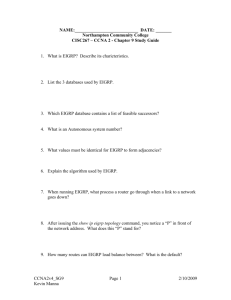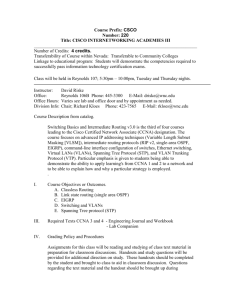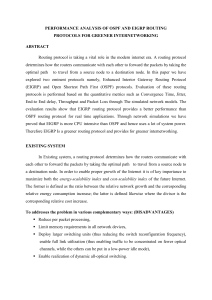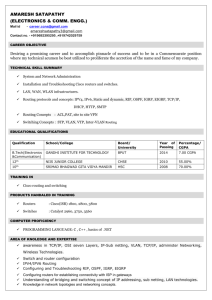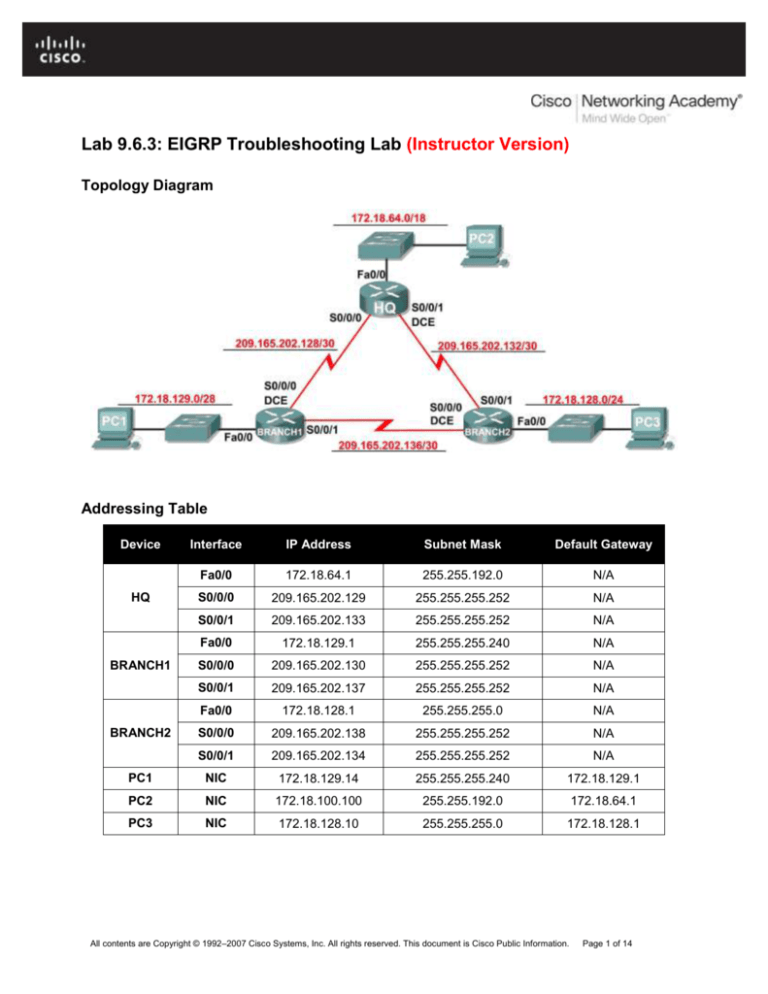
Lab 9.6.3: EIGRP Troubleshooting Lab (Instructor Version)
Topology Diagram
Addressing Table
Device
Interface
IP Address
Subnet Mask
Default Gateway
Fa0/0
172.18.64.1
255.255.192.0
N/A
S0/0/0
209.165.202.129
255.255.255.252
N/A
S0/0/1
209.165.202.133
255.255.255.252
N/A
Fa0/0
172.18.129.1
255.255.255.240
N/A
S0/0/0
209.165.202.130
255.255.255.252
N/A
S0/0/1
209.165.202.137
255.255.255.252
N/A
Fa0/0
172.18.128.1
255.255.255.0
N/A
S0/0/0
209.165.202.138
255.255.255.252
N/A
S0/0/1
209.165.202.134
255.255.255.252
N/A
PC1
NIC
172.18.129.14
255.255.255.240
172.18.129.1
PC2
NIC
172.18.100.100
255.255.192.0
172.18.64.1
PC3
NIC
172.18.128.10
255.255.255.0
172.18.128.1
HQ
BRANCH1
BRANCH2
All contents are Copyright © 1992–2007 Cisco Systems, Inc. All rights reserved. This document is Cisco Public Information.
Page 1 of 14
CCNA Exploration
Routing Protocols and Concepts: EIGRP
Lab 9.6.3: EIGRP Troubleshooting Lab
Learning Objectives
Upon completion of this lab, you will be able to:
Cable a network according to the Topology Diagram.
Erase the startup configuration and reload a router to the default state.
Load the routers with supplied scripts.
Discover where communication is not possible.
Gather information about the misconfigured portion of the network along with any other errors.
Analyze information to determine why communication is not possible.
Propose solutions to network errors.
Implement solutions to network errors.
Document the corrected network.
Scenario
In this lab, you will begin by loading configuration scripts on each of the routers. These scripts contain
errors that will prevent end-to-end communication across the network. You will need to troubleshoot each
router to determine the configuration errors, and then use the appropriate commands to correct the
configurations. When you have corrected all of the configuration errors, all of the hosts on the network
should be able to communicate with each other.
The network should also have the following requirements met:
EIGRP routing is configured on the BRANCH1 router.
EIGRP routing is configured on the BRANCH2 router.
EIGRP routing is configured on the HQ router.
EIGRP updates must be disabled on the BRANCH1, BRANCH2, and HQ LAN interfaces.
All EIGRP routers must use a process ID of 1.
Task 1: Cable, Erase, and Reload the Routers.
Step 1: Cable a network.
Cable a network that is similar to the one in the Topology Diagram.
Step 2: Clear the configuration on each router.
Clear the configuration on each of the routers using the erase startup-config command and then
reload the routers. Answer no if asked to save changes.
Task 2: Load Routers with the Supplied Scripts.
Step 1: Load the following script onto the BRANCH1 router:
[Instructor Note: Missing or misconfigured commands are shown in red]
hostname BRANCH1
!
no ip domain-lookup
!
interface FastEthernet0/0
ip address 172.18.129.1 255.255.255.240
All contents are Copyright © 1992–2007 Cisco Systems, Inc. All rights reserved. This document is Cisco Public Information.
Page 2 of 14
CCNA Exploration
Routing Protocols and Concepts: EIGRP
Lab 9.6.3: EIGRP Troubleshooting Lab
duplex auto
speed auto
! the no shutdown command is missing
!
interface Serial0/0/0
ip address 209.165.202.130 255.255.255.252
clock rate 64000
no shutdown
!
interface Serial0/0/1
ip address 209.165.202.137 255.255.255.252
no shutdown
!
router eigrp 2
!The AS number should be 1
passive-interface FastEthernet0/0
network 209.165.202.128 0.0.0.3
network 209.165.202.136 0.0.0.3
network 172.18.129.0 0.0.0.7
!The 172.18.129.0 network mask should be 0.0.0.15
no auto-summary
!
ip classless
!
line con 0
line vty 0 4
login
!
end
Corrected Script:
hostname BRANCH1
!
no ip domain-lookup
!
interface FastEthernet0/0
ip address 172.18.129.1 255.255.255.240
duplex auto
speed auto
no shutdown
!
interface Serial0/0/0
ip address 209.165.202.130 255.255.255.252
clock rate 64000
no shutdown
!
interface Serial0/0/1
ip address 209.165.202.137 255.255.255.252
no shutdown
!
router eigrp 1
passive-interface FastEthernet0/0
network 209.165.202.128 0.0.0.3
network 172.18.129.0 0.0.0.15
network 209.165.202.136 0.0.0.3
no auto-summary
!
All contents are Copyright © 1992–2007 Cisco Systems, Inc. All rights reserved. This document is Cisco Public Information.
Page 3 of 14
CCNA Exploration
Routing Protocols and Concepts: EIGRP
Lab 9.6.3: EIGRP Troubleshooting Lab
ip classless
!
line con 0
line vty 0 4
login
!
end!
!
end
The errors in the student scripts are as follows:
The no shutdown command is missing from the FastEthernet0/0 interface.
The EIGRP AS number is incorrect
The network mask for the 172.18.129.0/28 network is incorrect.
Step 2: Load the following script onto the BRANCH2 router:
hostname BRANCH2
!
no ip domain-lookup
!
interface FastEthernet0/0
ip address 172.18.128.1 255.255.255.0
duplex auto
speed auto
no shutdown
!
interface Serial0/0/0
ip address 209.165.202.138 255.255.255.252
clock rate 64000
no shutdown
!
interface Serial0/0/1
ip address 209.165.202.134 255.255.255.252
no shutdown
!
router eigrp 1
passive-interface FastEthernet0/0
network 172.18.128.0 0.0.0.255
network 209.165.202.132 0.0.0.3
network 209.165.202.136 0.0.0.3
!The no auto-summary command is missing
!
ip classless
!
line con 0
line vty 0 4
login
!
end
Corrected Script:
hostname BRANCH2
!
no ip domain-lookup
All contents are Copyright © 1992–2007 Cisco Systems, Inc. All rights reserved. This document is Cisco Public Information.
Page 4 of 14
CCNA Exploration
Routing Protocols and Concepts: EIGRP
Lab 9.6.3: EIGRP Troubleshooting Lab
!
interface FastEthernet0/0
ip address 172.18.128.1 255.255.255.0
duplex auto
speed auto
no shutdown
!
interface Serial0/0/0
ip address 209.165.202.138 255.255.255.252
clock rate 64000
no shutdown
!
interface Serial0/0/1
ip address 209.165.202.134 255.255.255.252
no shutdown
!
router eigrp 1
passive-interface FastEthernet0/0
network 172.18.128.0 0.0.0.255
network 209.165.202.132 0.0.0.3
network 209.165.202.136 0.0.0.3
no auto-summary
!
ip classless
!
line con 0
line vty 0 4
login
!
end
The errors in the student scripts are as follows:
The no auto-summary command is missing from the EIGRP configuration.
All contents are Copyright © 1992–2007 Cisco Systems, Inc. All rights reserved. This document is Cisco Public Information.
Page 5 of 14
CCNA Exploration
Routing Protocols and Concepts: EIGRP
Lab 9.6.3: EIGRP Troubleshooting Lab
Step 3: Load the following script onto the HQ router:
hostname HQ
!
no ip domain-lookup
!
interface FastEthernet0/0
ip address 172.18.64.1 255.255.192.0
duplex auto
speed auto
no shutdown
!
interface Serial0/0/0
ip address 209.165.202.129 255.255.255.252
no shutdown
!
interface Serial0/0/1
ip address 209.165.202.133 255.255.255.252
clock rate 64000
no shutdown
!
router eigrp 1
passive-interface Serial0/0/0
!The passive-interface command should use FastEthernet0/0
network 172.18.64.0
!The mask 0.0.63.255 is missing
!from the network statement for 172.18.64.0
network 209.165.202.128 0.0.0.3
network 209.165.202.132 0.0.0.3
no auto-summary
!
ip classless
!
line con 0
line vty 0 4
login
!
end
Corrected Script
hostname HQ
!
no ip domain-lookup
!
interface FastEthernet0/0
ip address 172.18.64.1 255.255.192.0
duplex auto
speed auto
no shutdown
!
interface Serial0/0/0
ip address 209.165.202.129 255.255.255.252
no shutdown
!
interface Serial0/0/1
ip address 209.165.202.133 255.255.255.252
All contents are Copyright © 1992–2007 Cisco Systems, Inc. All rights reserved. This document is Cisco Public Information.
Page 6 of 14
CCNA Exploration
Routing Protocols and Concepts: EIGRP
Lab 9.6.3: EIGRP Troubleshooting Lab
clock rate 64000
no shutdown
!
router eigrp 1
passive-interface FastEthernet0/0
network 172.18.64.0 0.0.63.255
network 209.165.202.128 0.0.0.3
network 209.165.202.132 0.0.0.3
no auto-summary
!
ip classless
!
line con 0
line vty 0 4
login
!
end
The errors in the student scripts are as follows:
The passive-interface command is configured for the incorrect interface.
The 0.0.63.255 mask is missing from the network statement for the 172.18.64.0/18 network.
Task 3: Troubleshoot the BRANCH1 Router.
Step 1: Begin troubleshooting at the Host connected to the BRANCH1 router.
From the host PC1, is it possible to ping PC2? _______ no
From the host PC1, is it possible to ping PC3? _______ no
From the host PC1, is it possible to ping the default gateway? _______ no
Step 2: Examine the BRANCH1 router to find possible configuration errors.
Begin by viewing the summary of status information for each interface on the router.
Are there any problems with the configuration of the interfaces?
____________________________________________________________________________________
Yes, the FastEthernet0/0 interface is administratively down.
____________________________________________________________________________________
All contents are Copyright © 1992–2007 Cisco Systems, Inc. All rights reserved. This document is Cisco Public Information.
Page 7 of 14
CCNA Exploration
Routing Protocols and Concepts: EIGRP
Lab 9.6.3: EIGRP Troubleshooting Lab
If there are any problems with the configuration of the interfaces, record any commands that will be
necessary to correct the configuration errors.
_____________________________________________ configure terminal
_____________________________________________ interface FastEthernet0/0
_____________________________________________ no shutdown
Step 3: If you have recorded any commands above, apply them to the router configuration now.
Step 4: View summary of the status information.
If any changes were made to the configuration in the previous step, view the summary of the status
information for the router interfaces again.
Does the information in the interface status summary indicate any configuration errors on the BRANCH1
router? _______ no
If the answer is yes, troubleshoot the interface status of the interfaces again.
Step 5: Troubleshoot the routing configuration on the BRANCH1 router.
What routes are shown in the routing table?
_____________________________________________ 172.18.129.0 is directly connected
_____________________________________________ 209.165.202.128 is directly connected
_____________________________________________ 209.165.202.136 is directly connected
Are there any problems with the routing table or the EIGRP configuration?
____________________________________________________________________________________
Yes, there are no EIGRP routes in the routing table. The process ID for EIGRP is incorrect.
____________________________________________________________________________________
The 172.18.129.0 network mask is incorrect. It should be 0.0.0.15.
If there are any problems with the EIGRP configuration, record any commands that will be necessary to
correct the configuration errors.
_____________________________________________ no router eigrp 2
_____________________________________________ router eigrp 1
_____________________________________________ passive-interface FastEthernet0/0
_____________________________________________ network 209.165.202.128 0.0.0.3
_____________________________________________ network 209.165.202.136 0.0.0.3
_____________________________________________ network 172.18.129.0 0.0.0.15
_____________________________________________ no auto-summary
Are there any connectivity problems that could be due to errors on other parts of the network?
No _________________________________________________________________________________
____________________________________________________________________________________
All contents are Copyright © 1992–2007 Cisco Systems, Inc. All rights reserved. This document is Cisco Public Information.
Page 8 of 14
CCNA Exploration
Routing Protocols and Concepts: EIGRP
Lab 9.6.3: EIGRP Troubleshooting Lab
What connected networks are shown in the EIGRP topology table of the BRANCH1 router?
_____________________________________________ 172.18.129.0/28
_____________________________________________ 209.165.202.128/30
_____________________________________________ 209.165.202.136/30
Are there any problems with the connected networks in the EIGRP topology table?
No ________________________________________________________________________________
____________________________________________________________________________________
Step 6: If you have recorded any commands above, apply them to the router configuration now.
Step 7: View the routing information.
If any changes were made to the configuration in the previous steps, view the routing information again.
Does the information in routing table indicate any configuration errors on the BRANCH1 router? _______
no
Does the information in the EIGRP topology table indicate any configuration errors on the BRANCH1
router? _______ no
If the answer to either of these questions is yes, troubleshoot the routing configuration again.
What routes are shown in the routing table?
__________________________________________________ 172.18.64.0/18 via 209.165.202.129
__________________________________________________ 172.18.129.0/28 is directly connected
__________________________________________________ 209.165.202.128 is directly connected
__________________________________________________ 209.165.202.132 via 209.165.202.129
__________________________________________________ 209.165.202.136 is directly connected
Step 8: Attempt to ping between the hosts again.
From the host PC1, is it possible to ping PC2? _______ no
From the host PC1, is it possible to ping PC3? _______ no
From the host PC1, is it possible to ping the Serial 0/0/0 interface of the HQ router? _______ yes
From the host PC1, is it possible to ping the Serial 0/0/1 interface of the HQ router? _______ yes
Task 4: Troubleshoot the HQ Router
Step 1: Begin troubleshooting at the host PC2.
From the host PC2, is it possible to ping PC1? _______ no
From the host PC2, is it possible to ping PC3? _______ yes
From the host PC2, is it possible to ping the default gateway? _______ yes
Step 2: Examine the HQ router to find possible configuration errors.
Begin by viewing the summary of status information for each interface on the router.
Are there any problems with the configuration of the interfaces?
Begin by viewing the summary of status information for each interface on the router.
All contents are Copyright © 1992–2007 Cisco Systems, Inc. All rights reserved. This document is Cisco Public Information.
Page 9 of 14
CCNA Exploration
Routing Protocols and Concepts: EIGRP
Lab 9.6.3: EIGRP Troubleshooting Lab
Are there any problems with the configuration of the interfaces? no
____________________________________________________________________________________
____________________________________________________________________________________
____________________________________________________________________________________
If there are any problems with the configuration of the interfaces, record any commands that will be
necessary to correct the configuration errors.
____________________________________________________________________________________
____________________________________________________________________________________
____________________________________________________________________________________
Step 3: If you have recorded any commands above, apply them to the router configuration now.
Step 4: View summary of the status information.
If any changes were made to the configuration in the previous step, view the summary of the status
information for the router interfaces again.
Does the information in the interface status summary indicate any configuration errors on the HQ router?
_______ no
If the answer is yes, troubleshoot the interface status of the interfaces again.
Step 5: Troubleshoot the routing configuration on the HQ router.
What routes are shown in the routing table?
________________________________________________ 172.18.0.0/16 is a summary
________________________________________________ 172.18.64.0/18 is directly connected
________________________________________________ 209.165.202.128/30 is directly connected
________________________________________________ 209.165.202.132/30 is directly connected
________________________________________________ 209.165.202.136 via 209.165.202.134
Are there any problems with the routing table or the EIGRP configuration?
____________________________________________________________________________________
____________________________________________________________________________________
____________________________________________________________________________________
____________________________________________________________________________________
____________________________________________________________________________________
____________________________________________________________________________________
The 172.18.128.0/24 network is missing from the routing table.
Only the summary route 172.18.0.0/16 network is being received from the BRANCH2 router.
The mask is missing from the network statement for the 172.16.64.0/18 network.
The passive-interface command is configured for the wrong interface.
All contents are Copyright © 1992–2007 Cisco Systems, Inc. All rights reserved. This document is Cisco Public Information.
Page 10 of 14
CCNA Exploration
Routing Protocols and Concepts: EIGRP
Lab 9.6.3: EIGRP Troubleshooting Lab
If there are any problems with the EIGRP configuration, record any commands that will be necessary to
correct the configuration errors.
________________________________________________ router eigrp 1
________________________________________________ no network 172.18.64.0
________________________________________________ network 172.18.64.0 0.0.63.255
________________________________________________ no passive-interface serial0/0/0
________________________________________________ passive-interface FastEthernet0/0
Are there any connectivity problems that could be due to errors on other parts of the network?
No _________________________________________________________________________________
____________________________________________________________________________________
____________________________________________________________________________________
What connected networks are shown in the EIGRP topology table of the HQ router?
________________________________________________ 172.18.64.0/18
________________________________________________ 209.165.202.128/30
________________________________________________ 209.165.202.132/30
________________________________________________ 209.165.202.136/30
Are there any problems with the connected networks in the EIGRP topology table? no
____________________________________________________________________________________
____________________________________________________________________________________
Step 6: If you have recorded any commands above, apply them to the router configuration now.
Step 7: View the routing information.
If any changes were made to the configuration in the previous steps, view the routing information again.
Does the information in routing table indicate any configuration errors on the HQ router? _______ no
Does the information in the EIGRP topology table indicate any configuration errors on the HQ router?
_______ no
If the answer to either of these questions is yes, troubleshoot the routing configuration again.
Step 8: Attempt to ping between the hosts again.
From the host PC2, is it possible to ping PC1? _______ yes
From the host PC2, is it possible to ping PC3? _______ yes
From the host PC2, is it possible to ping the Serial 0/0/0 interface of the BRANCH2 router? _______ yes
From the host PC2, is it possible to ping the Serial 0/0/1 interface of the BRANCH2 router? _______ yes
Task 5: Troubleshoot the BRANCH2 Router
Step 1: Begin troubleshooting at the Host PC3.
From the host PC3, is it possible to ping PC1? _______ no
From the host PC3, is it possible to ping PC2? _______ yes
All contents are Copyright © 1992–2007 Cisco Systems, Inc. All rights reserved. This document is Cisco Public Information.
Page 11 of 14
CCNA Exploration
Routing Protocols and Concepts: EIGRP
Lab 9.6.3: EIGRP Troubleshooting Lab
From the host PC3, is it possible to ping the default gateway? _______ yes
Step 2: Examine the BRANCH2 router to find possible configuration errors.
Are there any problems with the configuration of the interfaces?
No _________________________________________________________________________________
____________________________________________________________________________________
____________________________________________________________________________________
If there are any problems with the configuration of the interfaces, record any commands that will be
necessary to correct the configuration errors.
None ___________________________________________
________________________________________________
________________________________________________
Step 3: If you have recorded any commands above, apply them to the router configuration now.
Step 4: View summary of the status information.
If any changes were made to the configuration in the previous step, view the summary of the status
information for the router interfaces again.
Does the information in the interface status summary indicate any configuration errors on the BRANCH2
router? _______ no
If the answer is yes, troubleshoot the interface status of the interfaces again.
Step 5: Troubleshoot the routing configuration on the BRANCH2 router.
What routes are shown in the routing table?
________________________________________________ 172.18.0.0/16 is a summary
________________________________________________ 172.18.64.0/18 via 209.165.202.133
________________________________________________ 172.18.128.0/24 is directly connected
________________________________________________ 172.18.129.0/28 via 209.165.202.137
________________________________________________ 209.165.202.0/24 is a summary
________________________________________________ 209.165.202.128/30 via 209.165.202.133
via 209.165.202.137
________________________________________________ 209.165.202.132/30 is directly connected
________________________________________________ 209.165.202.136/30 is directly connected
Are there any problems with the routing table or the EIGRP configuration?
____________________________________________________________________________________
____________________________________________________________________________________
The no auto-summary command is missing.
If there are any problems with the EIGRP configuration, record any commands that will be necessary to
correct the configuration errors.
________________________________________________ router eigrp 1
________________________________________________ no auto-summary
All contents are Copyright © 1992–2007 Cisco Systems, Inc. All rights reserved. This document is Cisco Public Information.
Page 12 of 14
CCNA Exploration
Routing Protocols and Concepts: EIGRP
Lab 9.6.3: EIGRP Troubleshooting Lab
________________________________________________
Are there any connectivity problems that could be due to errors on other parts of the network?
no
____________________________________________________________________________________
____________________________________________________________________________________
____________________________________________________________________________________
What connected networks are shown in the EIGRP topology table of the BRANCH2 router?
________________________________________________ 172.18.128.0/24
________________________________________________ 209.165.202.132/30
________________________________________________ 209.165.202.136/30
Are there any problems with the connected networks in the EIGRP topology table? no
____________________________________________________________________________________
____________________________________________________________________________________
Step 6: If you have recorded any commands above, apply them to the router configuration now.
Step 7: View the routing information.
If any changes were made to the configuration in the previous steps, view the routing information again.
Does the information in routing table indicate any configuration errors on the BRANCH2 router? _______
no
Does the information in the EIGRP topology table indicate any configuration errors on the BRANCH2
router? _______ no
If the answer to either of these questions is yes, troubleshoot the routing configuration again.
What routes are shown in the routing table?
________________________________________________ 172.18.0.0/16 is a summary
________________________________________________ 172.18.64.0/18 via 209.165.202.133
________________________________________________ 172.18.128.0/24 is directly connected
________________________________________________ 172.18.129.0/28 via 209.165.202.137
________________________________________________ 209.165.202.0/24 is a summary
________________________________________________ 209.165.202.128/30 via 209.165.202.133
via 209.165.202.137
________________________________________________ 209.165.202.132/30 is directly connected
________________________________________________ 209.165.202.136/30 is directly connected
Step 8: Attempt to ping between the hosts again.
From the host PC3, is it possible to ping PC1? _______ yes
From the host PC3, is it possible to ping PC2? _______ yes
From the host PC3, is it possible to ping the Serial 0/0/0 interface of the BRANCH1 router? _______ yes
From the host PC3, is it possible to ping the Serial 0/0/1 interface of the BRANCH1 router? _______ yes
All contents are Copyright © 1992–2007 Cisco Systems, Inc. All rights reserved. This document is Cisco Public Information.
Page 13 of 14
CCNA Exploration
Routing Protocols and Concepts: EIGRP
Lab 9.6.3: EIGRP Troubleshooting Lab
Task 6: Reflection
There were a number of configuration errors in the scripts that were provided for this lab. Use the space
below to write a brief description of the errors that you found.
___________________________________________________________________________________
___________________________________________________________________________________
___________________________________________________________________________________
___________________________________________________________________________________
___________________________________________________________________________________
BRANCH1 – FA0/0 was administratively down.
The process ID for EIGRP was 2 vs. 1.
The network mask for 172.18.129.0 was 0.0.0.7 vs. 0.0.0.15.
HQ – The network mask 0.0.63.255 was missing for 172.18.64.0.
Passive-Interface was assigned Serial0/0/0 vs. FA0/0.
BRANCH2 – the No Auto-Summary command was missing in the EIGRP routing protocol.
Task 7: Documentation
On each router, capture the following command output to a text (.txt) file and save for future reference.
show running-config
show ip route
show ip interface brief
show ip protocols
If you need to review the procedures for capturing command output, refer to Lab 1.5.1
Task 8: Clean Up
Erase the configurations and reload the routers. Disconnect and store the cabling. For PC hosts that are
normally connected to other networks (such as the school LAN or to the Internet), reconnect the
appropriate cabling and restore the TCP/IP settings.
All contents are Copyright © 1992–2007 Cisco Systems, Inc. All rights reserved. This document is Cisco Public Information.
Page 14 of 14







